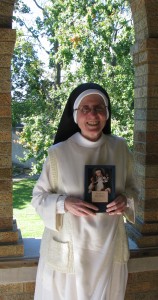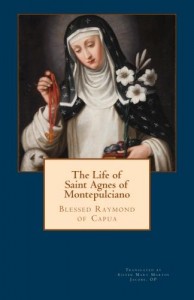
As mentioned in our earlier post, we just published the first English translation of The Life of Saint Agnes of Montepulciano by Blessed Raymond of Capua, OP. Below is an interview with our Sr. Mary Martin who translated the Life.
How long have you been in the monastery?
I've been in the monastery 45 years.
How did this translation project come about?
We were offered a one month free trial to the online version of Acta Sanctorum, a subscription to which would have cost us $25,000. So we began madly copying anything pertaining to Dominican Saints and Blesseds. I really wanted the canonization process of St. Margaret of Hungary, but they had only the introduction to that, but the whole Life of St. Agnes. So I started working on that. I pretty quickly realized that the copy I downloaded was defective, with paragraphs missing from the bottoms of some pages, but I didn't realize how defective until I was able to obtain a copy of the new critical edition.
What language was the original life by Blessed Raymond written in?
Latin
How long have you studied Latin?
I took Latin for 4 years in school and honed my skills in the monastery on our liturgical and legislative texts.
How long has it taken you to complete the translation?
It took about 4 years, but after awhile I just stopped counting.
How did you find time to work on the translation in the midst of your busy life as a Dominican Nun?
We have time for study built into our schedule although things have a way of eating into the time. That's why it took so long!
Did you have any particular interest in St Agnes of Montepulciano before you began translating her life? If so, what?
No, I never found St. Agnes particularly appealing and hoped to make her acquaintance through the Life.
How do you feel about her after completing the translation?
You'll have to read the Translator's Preface to find out!
Why do you think this book is important, or DO you think it is important?
The reason why I am interested in early writings by and about the nuns is I have always been curious as to how the nuns really lived their day to day life in those early times. That's why I felt the book was important enough to translate, and there are some interesting things in it about the way the nuns lived and about how they and others viewed their life in the monastery.
What do you hope that people who read your translation will gain from the book?
If ordinary people can be edified by what they read here, more power to them! For the nuns, I hope we can see that a life of genuine holiness is attractive to others, well beyond the enclosure walls. Also, real miracles can and do happen, or at least did in those days.
What does it feel like to finally be finished?
Relieved and exhilarated.
Is this your first translation or have you translated other books?
I translated the Rule of San Sisto and the Statutes of the Penitents of St. Mary Magdalen, which embody the earliest legislation of the nuns of the Order and were in large measure copied from the early legislation of the friars. Before that I was a member of the international commission that produced the official English translation of our revised Constitutions in 1987.
Are you planning on translating any more books?
I'll think about it, especially if I ever get a copy of the canonization process of St. Margaret of Hungary.
Who gave you the most encouragement and support in this endeavor?
Sr. Mary Jeremiah of the Lufkin monastery; also Sr. Maria of the Cross who was always interested in my translation project and Sr. Mary Catharine.
If you were to write a Life of Saint Agnes of Montepulciano, how would yours be different from Blessed Raymond's?
If I were to write a life, it would be, insofar as I am able, in conformity with modern standards of historical research, and I would try to understand the person's feelings, motivations, etc. as well as trace their correspondence to the grace of God working in their life.

